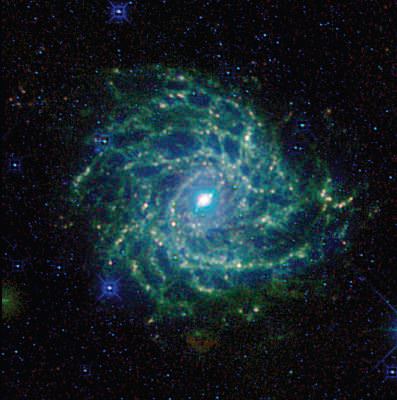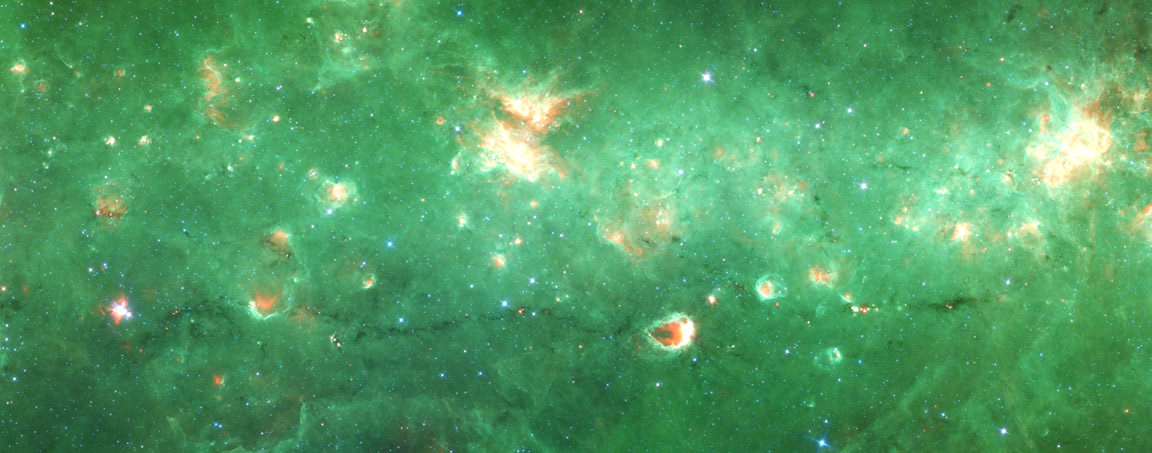Astronomers have found what may be considered a piece of a galactic skeleton; a dark structure of gas and dust that might provide a backbone on which one of the spiral arms extend from the central bar of the Milky Way galaxy.
“This ‘bone’ is likely made from high density gas — the type that forms stars — and while the feature that we see is a sinuous distinction you get from dust, there is a huge amount of gas,” said Alyssa Goodman of the Harvard-Smithsonian Center for Astrophysics (CfA) at a press conference at the American Astronomical Society meeting in Long Beach, California today. “But we just don’t know yet what it is.”

While this is the first time such a structure has been seen in our own galaxy, other spiral galaxies seemingly display internal “endoskeletons.” Observations, especially at infrared wavelengths of light, have found long skinny features jutting between galaxies’ spiral arms. These relatively straight structures are much less massive than the curving spiral arms.
Goodman said that since we view the Milky Way from the inside, its exact structure is difficult to determine, but it is thought to have a central bar and two major spiral arms that wrap around its disk.
A team of astronomers first spotted the galactic bone while studying a dust cloud nicknamed “Nessie,” since its shape is reminiscent of the Loch Ness monster. The central part of the “Nessie” bone was discovered in Spitzer Space Telescope data in 2010 by James Jackson (Boston University). With further analysis, Goodman’s team determined the dark cloud goes way beyond the original section that was first found, and is as much as eight times longer than Jackson’s original sighting.
Radio emissions from molecular gas show that the feature is not a chance projection of material on the sky, but instead a real feature. Not only is “Nessie” in the galactic plane, but also it extends much longer than anyone anticipated. This slender bone of the Milky Way is more than 300 light-years long but only 1 or 2 light-years wide. It contains about 100,000 suns’ worth of material, and now looks more like a cosmic snake.
“This bone is much more like a fibula – the long skinny bone in your leg – than it is like the tibia, or big thick leg bone,” Goodman said.
It lies along the plane of the Milky Way, and since our vantage point is just above the the plane, Goodman and her team are hopeful that the skeleton may be able to be mapped.
“It’s possible that the ‘Nessie’ bone lies within a spiral arm, or that it is part of a web connecting bolder spiral features. Our hope is that we and other astronomers will find more of these features, and use them to map the skeleton of the Milky Way in 3-D,” she said.
The team’s paper is not quite finished yet, but it is online on the new open source scientific collaboration site, Authorea.
For more information, visit http://milkywaybones.org.


Are these spines thought to be any denser than dark nebula?
Or are they dark nebula with a curious appearance/formation?
If they are dark nebulae, this could be an indicator of a helluva gravitational effect there to stretch it out like that!
Presumably, such dense filaments of gas could have some quite significant gravitational influence over the structure of galaxies, especially if their path correlates closely to the location of spiral arms?
Actually the existence of such a filament of gas which stretches out 300 light years can presently be explained with some quite “freaky” theories of gravitation. For something to stretch out so far out along and not itself be affected much by gravity of other stars nearby to it is itself strange.
There are some theories like String Theory which hypothesize the existence of such gravitational “filaments” linking far off areas and even between galaxies.
These are cosmic strings. These are one dimensional filaments where the Lagrangian for field theory is not broken by the Higgs mechanism. Gas bubbles in ice cubes are a sort of ordinary analogue of this. These are then high energy, thus by E = mc^2 large mass, filaments that have gravitation. If one works Gauss’ law the gravity field is approximately logarithmic near the filament. These could have played a role in the early formation of galaxies. However, cosmic strings are probably not that stable and they likely decayed away a early in the history of the universe.
LC
On the contrary, this piece of a spiral galactic arm is currently only modeled within the standard cosmology. The first successful detailed simulation of a spiral galaxy was the Eris simulation, and it depended crucially on dark matter physics:
“Simulation projects intending to simulate spiral galaxies have been undertaken for the past 20 years. All of these projects had failed as the simulation results showed central bulges which are huge compared to the disk size.”
[ http://en.wikipedia.org/wiki/Eris_(simulation) ]
That was the remaining area for dark matter to be tested in. Alternate (effective) theories of gravitation and/or cosmology has now failed on all scales including structure formation from galaxy clusters down to spiral galaxies.
Such theories build on the effective theory of general relativity. (Which itself is tested on smaller structures of structure formation.) String theory on the other hand can among other things build a fundamental gravity theory, and can be used to build physics where general relativity is the outcome.
These structures are fascinating examples of how having better eyes on the sky yield unexpected findings that are essential pieces of lonstanding cosmologic puzzles. My first impression is that this structure could only have formed in this way under the influence of dark matter. It also supports the theories dark matter beign diffusely spread through the galaxy rather than centrally concentrated. I had been in this latter camp, but will be rethinking my position after considering this finding.
The ‘bar’ structures seen in many ‘face on’ galaxies resemble nothing less than humongous spinning garden sprinklers! Makes it tempting to try to unwind the spiral arms back to their sources? What I find interesting is how the bar structure in galaxies resemble those bar structures in newly forming stars as recently seen by the ALMA array – HD 142527 – This star appears to be making planets with a ‘bar shaped’ plasma/dust jet(s)! Fractal atoms?
http://www.eso.org/public/archives/releases/sciencepapers/eso1301/eso1301a.pdf